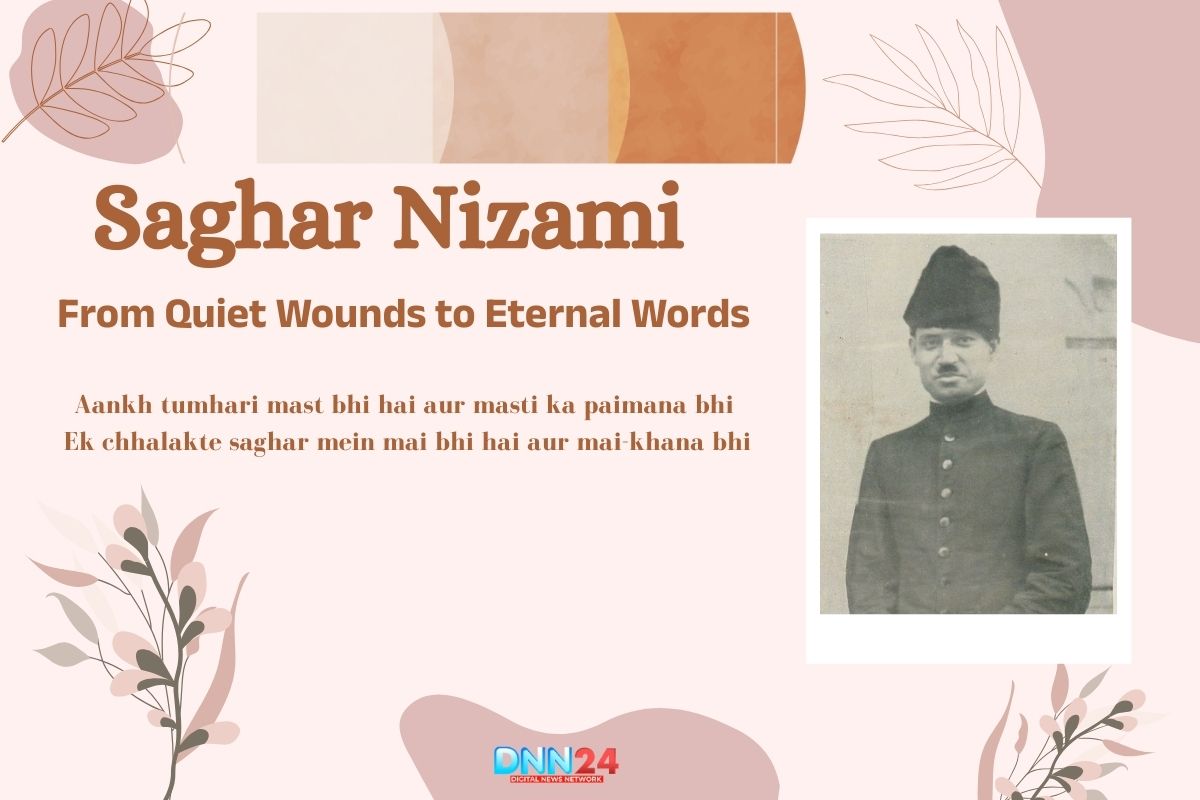On a winter’s day in 1905, in the historic lanes of Aligarh, a child named Samad Yar Khan, later celebrated as Saghar Nizami, entered a world caught between tradition and the changes of British India. His father was a well-respected doctor serving the British government, and he had dreamt of safety and stability.
hairat se tak raha hai jahan-e-wafa mujhe
Saghar Nizami
tum ne bana diya hai mohabbat mein kya mujhe
A better life for his family, but the spirit of little Saghar Nizami was inclined softly towards poetry and contemplation. He would sit under a tree, the neem tree, lost in thought in the vast family home, and watch the sun rays play on the dust particles and churn verses in his head. He was not a loud or demanding child, as many are, but his questions had a low tone, and his feelings were strong.
yun na rah rah kar hamein tarsaiye
Saghar Nizami
aaiye aa jaiye aa jaiye
His dreamy attitude attracted the teasing of his classmates. However, it was one day, following a very cruel teasing, that young Saghar took refuge in words-he wrote his suffering down on a piece of old paper. The poem that he wrote that evening, which was hidden in a family trunk, was never discovered during his life. It was found out by a relative decades later.
aankh tumhaari mast bhi hai aur masti ka paimana bhi
Saghar Nizami
ek chhalakte saghar mein mai bhi hai aur mai-KHana bhi
The lines told of a boy who wanted to fly, to touch stars with words, though always feeling firmly on the ground, and held the yearning and the hope of all the ‘quiet children’ who feel unseen. This soft vulnerability was Saghar’s secret power, the cut he had on his soul in life that cultivated in the garden of his poetry, transforming pain into wisdom and understanding.
dasht mein qais nahin koh pe farhad nahin
Saghar Nizami
hai wahi ishq ki duniya magar aabaad nahin
The Master and his Muse: Fear and Fire Lessons
In the bustling city of Agra, Saghar Nizami’s path crossed the legendary Seemab Akbarabadi, a meeting that would transform his destiny. Saghar was among the first of Seemab’s disciples. Saghar had a fragile confidence that was constantly put to the test under the stern and yet nurturing eyes of the great poet; Seemab was convinced that only suffering and perspective could make a good poet.
dosto durd pilao ki kaDi raat kaTe
Saghar Nizami
mai mein kuchh aur milao ki kaDi raat kaTe
At an early stage in his career as an editor of the magazine Paimana, a platform offered to him by his mentor, Saghar, he experienced countless sleepless nights of self-doubt and fear of what was written in the magazine, and the burden of the expectations.
sawan ki rut aa pahunchi kale baadal chhaenge
Saghar Nizami
kaliyan rang mein bhigengi phulon mein ras aaenge
At this time, a story was told by his fans: one of the most significant contributors once criticised Saghar, claiming that he had altered the tone of the magazine, saying that the fire in his poetry was put out by fear. Shaken, Saghar remained silent that night, but told one of her close friends, later, that, as she brings fire, she burns herself as well.
raaton ko tasawwur hai un ka aur chupke chupke rona hai
Saghar Nizami
ai subh ke tare tu hi bata anjam mera kya hona hai
Saghar never ceased to absorb and express his pain, even when he received public criticism and personal pain. It was a time of legendary literary arguments, early love disappointments and an obsessive search for literary truth. The ‘fires’ that his tutor required would scorch through Saghar’s poetry over the next several decades, but so would the modesty of a man who was not afraid of not being good enough and who nevertheless soldiered on.
hum aankhon se bhi arz-e-tamanna nahin karte
Saghar Nizami
mubham sa ishaara bhi gawara nahin karte
Foundations Built on Sand: Struggles, Setbacks, and Survival
1933 marked a dramatic turn as Saghar Nizami moved to Meerut, hungry to shape his legacy. He established Adabi Markaz, a literary publishing house that initially did not go well, as economic difficulties were about to break his dreams. During his early days, Saghar sold his father-given fountain pen, which was one of his only valuables, to pay employees at the press- he later joked many years later, “You can lose ink, you can lose words, but the story must be printed.”
phir rah-e-ishq wahi zad-e-safar mange hai
Saghar Nizami
waqt phir qalb-e-tapan dida-e-tar mange hai
With its meagre means, the first book of Adabi Markaz, the first book of Mehr Lal Soni Zia Fatehabadi, became a literary event, not only because of the poetry, but also because of the fierceness with which Saghar has been cultivating the voices of others.
nadim-e-dard-e-mohabbat baDa sahaara hai
Saghar Nizami
jabhi to ye gham-e-dauran hamein gawara hai
Behind the success he showed publicly, Nizami endured bitter personal losses- alienation from his family, who wanted him to choose a more secure career, and acute loneliness in the big city.He would write poems by oil lamp late at night, harassed by the doubts yet buoyed by the hope that words could yet change minds.
gesu ko tere ruKH se baham hone na denge
Saghar Nizami
hum raat ko KHurshid mein zam hone na denge
There is one more legend about a famous stormy night, when a print run was ruined by rain, and Saghar was sitting on the press floor picking up spoiled papers. He also wrote a new poem on those wet papers, which, afterwards, appeared in his masterpiece book titled Subuhi, and this was a testament to the passion, even tragedy, that brings forth art. These struggles marked the making of Saghar Nizami: he lost a lot, but never lost the courage to start again.
naghme hawa ne chheDe fitrat ki bansuri mein
Saghar Nizami
paida huin zabanen jangal ki KHamushi mein
The Legacy of Empathy: Words as Shelter and Revolution
Saghar Nizami’s writing became an anthem for those left on the margins—his ghazals and nazms teemed with longing, hope, and revolutionary empathy. It is said that when Master Madan sang Saghar on All India Radio, people who did not even know him cried as though their story was being sung out.
na kashti hai na fikr-e-na-KHuda hai
Saghar Nizami
dil-e-tufan-talab ka aasra hai
Saghar received untold favours: he would sometimes pay struggling poets out of his pocket, and on one occasion, presented a poor poet with his own highly prized Kashmiri shawl, when the poet turned up at his door shivering. He wrote a play, Anarkali, which dared to raise its voice against the cultural norms and created a niche for modern Urdu plays.
sadiyon ki shab-e-gham ko sahar hum ne banaya
Saghar Nizami
zarraat ko KHurshid o qamar hum ne banaya
Saghar was the same simple person despite the accolades he was awarded, with the Padma Bhushan in 1969, one of the highest civilian awards of India and the Ghalib Award (1982). Saghar still held the same view that pain is evidence of life.Later in life, he was beset by poor health and lost old friends, but he still wrote, mentored, and dreamed. One day, a young admirer timorously put the question, What is it that makes poetry so magical?
jo rahin-e-taghayyuraat nahin
Saghar Nizami
maut hai maut wo hayat nahin
And Saghar, smiling, answered, write those, every heart-break, every hope you dare not say– In a nutshell that is poetry.” His books of collected works, in three volumes, remain an inspiration, not only because they are poems, but because they are silent lanterns that show the lost and unheard their way through their darkness. He wrote, and today his legacy is not that he wrote, but that he created silent revolutions in each of us, who are broken and hopeful, and who read his words.
hui kam-zarfi-e-gham hijr mein giryan ho kar
Saghar Nizami
ek aansu ne Duboya hamein tufan ho kar
Also Read: Jan Nisar Akhtar: The Poet of Love, Revolution and Emotions
You can connect with DNN24 on Facebook, Twitter, and Instagram and subscribe to our YouTube channel.

